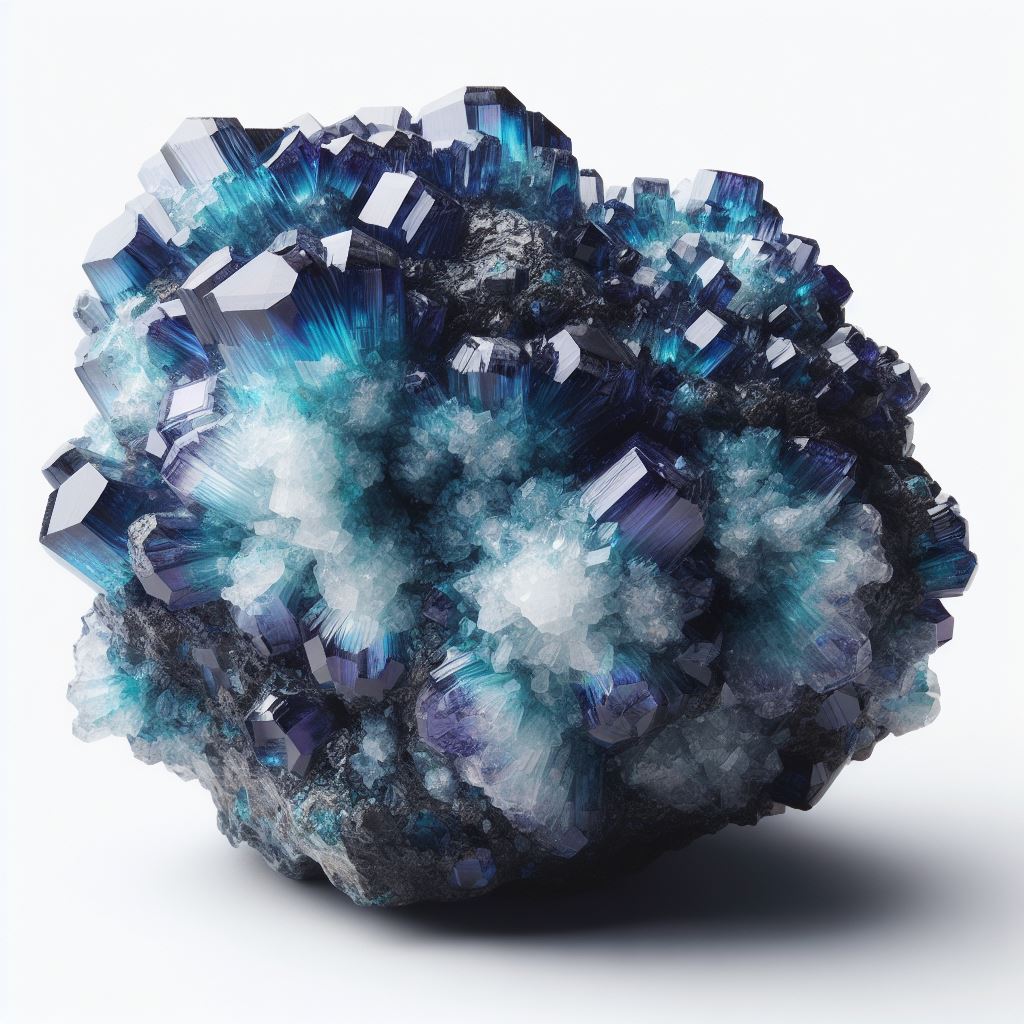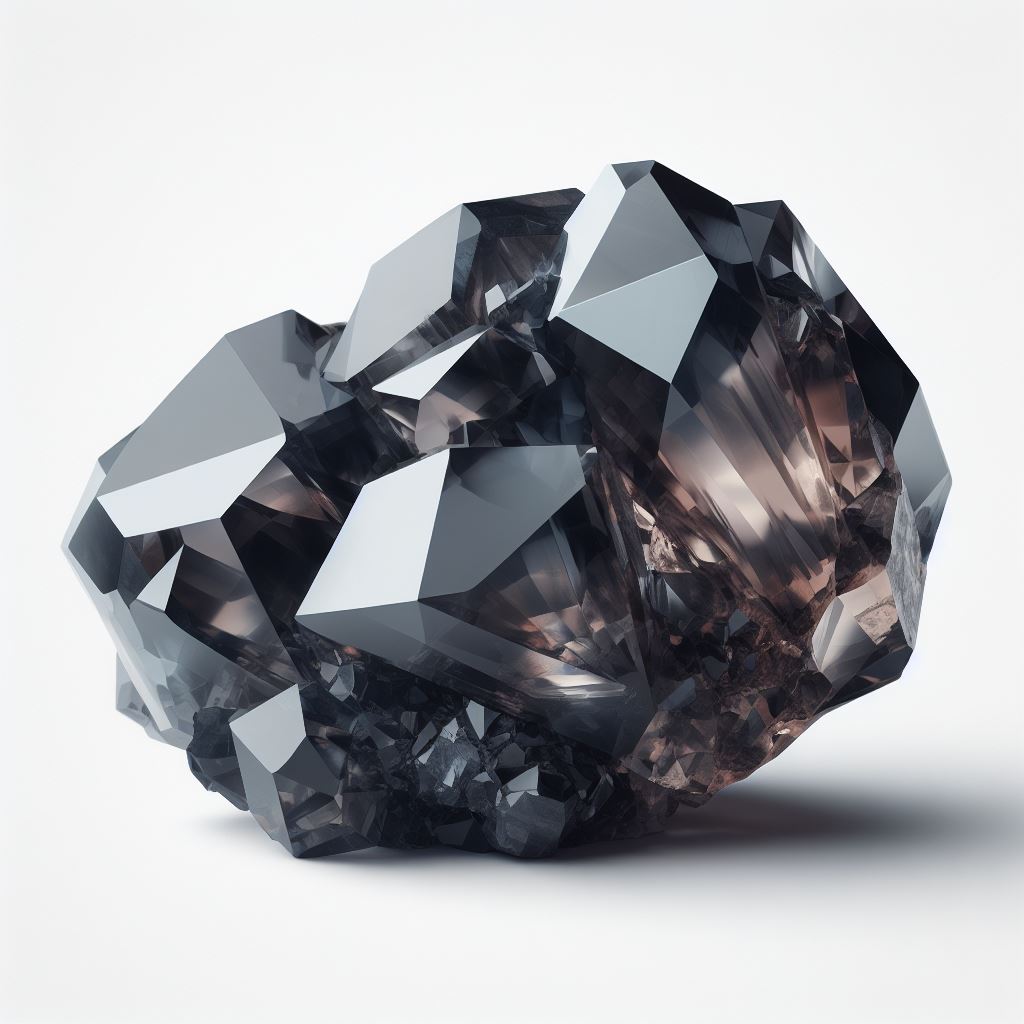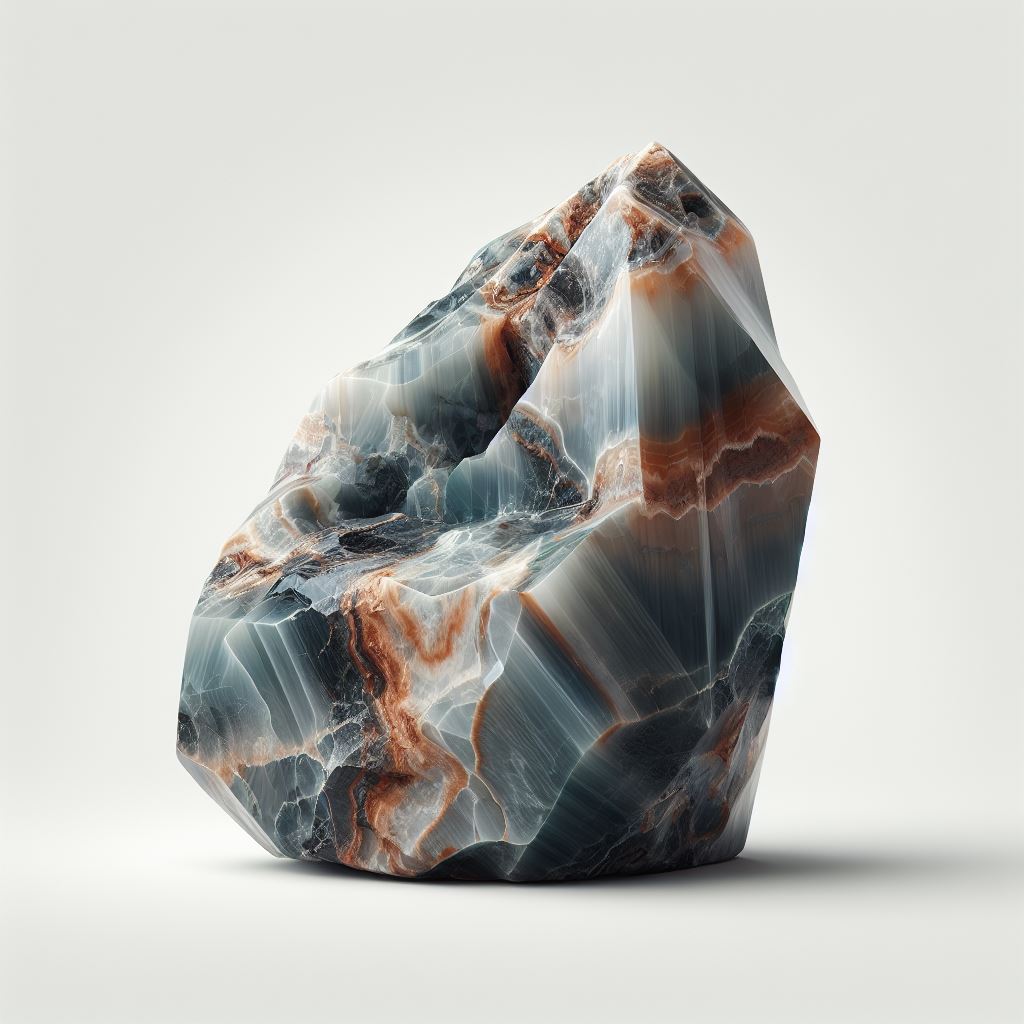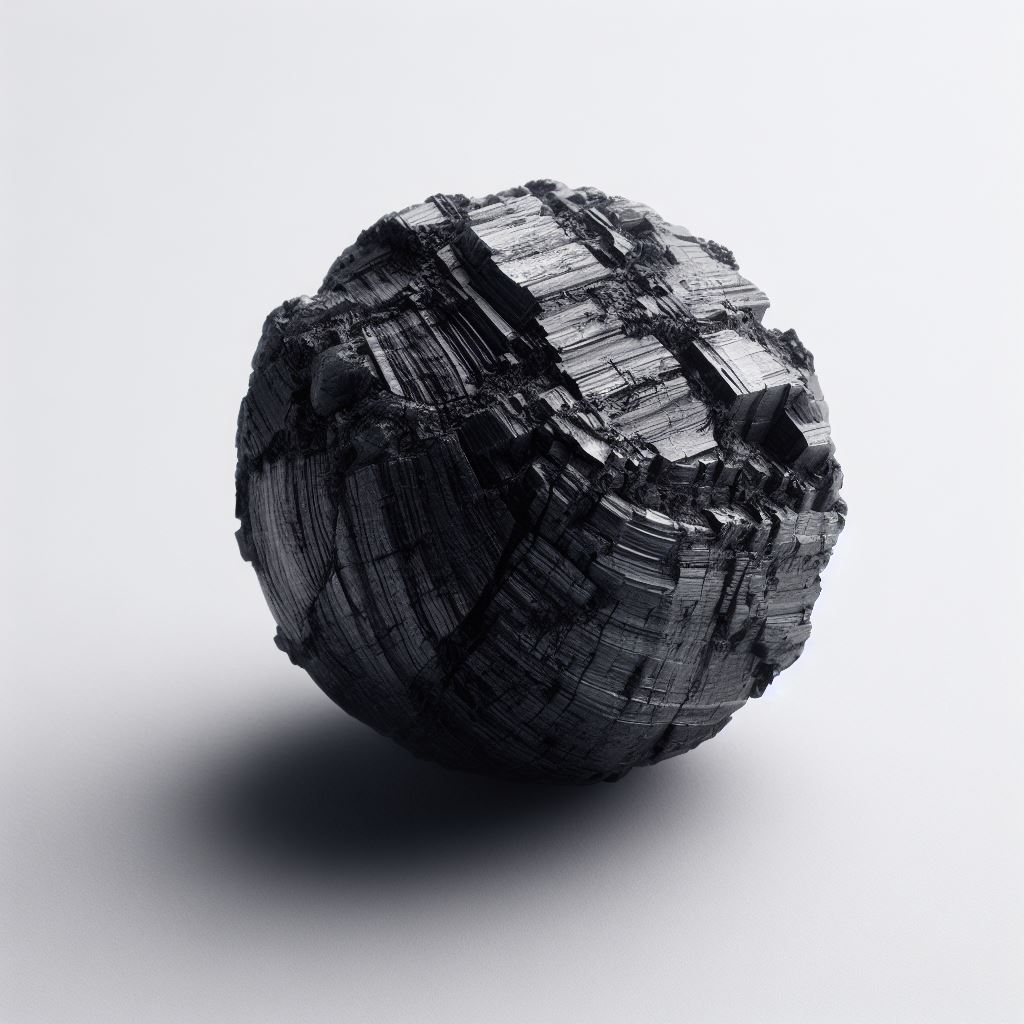Azurite crystal, an ornamental stone, is a captivating deep blue mineral that has a rich history dating back to ancient civilizations. This stunning rock, also known as green malachite, has fascinated people for centuries and was even used by famous artists like Raphael in their artwork. Forming in the oxidized zone of copper ore deposits, this exquisite azurite stone was initially discovered by our ancestors who were enthralled by its beauty. The azurite specimens are highly sought after for their ornamental stone qualities. Additionally, azurite pigment is derived from this stunning crystal. Azurite crystals, a type of stone specimen, were highly valued for their vibrant blue hues and unique formations. They were primarily used for decorative purposes due to their striking color and rock-like material.
The name “azurite” itself is derived from the Persian word “lazhward,” meaning blue stone. Throughout centuries, the mesmerizing azurite stone has fascinated art enthusiasts and collectors alike. This rock, also known as azurite specimens, has captivated people with its stunning beauty. In fact, it has been used as a source of azurite pigment for various artistic purposes. The allure of azurite stone lies not only in its stunning appearance but also in the metaphysical properties attributed to it. Azurite pigment and azurite specimens are highly sought after for their beauty and mystical qualities.
Join us on this journey as we uncover the secrets behind these captivating azurite stone specimens.
Evolution of Azurite Crystal Throughout History
Azurite crystal has a rich history that spans across various civilizations and time periods. Its vibrant blue color has been valued since ancient times, making it a sought-after gemstone for centuries.
Ancient Times: Azurite as a Pigment in Egyptian Tomb Paintings
In ancient Egypt, azurite was highly prized for its deep blue hue. It was ground into a fine powder and used as a pigment in tomb paintings, adding an exquisite touch to the artwork. The Egyptians believed that the vivid blue color represented the heavens and symbolized rebirth and eternal life.
Medieval Era: Illuminated Manuscripts Adorned with Azurite
During the Middle Ages, azurite continued to be treasured for its intense blue shade. It found its way into medieval illuminated manuscripts, where scribes meticulously incorporated it into intricate illustrations. These manuscripts were adorned with gold leaf accents and embellished with azurite pigments, creating stunning visual masterpieces.
Renaissance: Azurite’s Influence on Renaissance Art
The Renaissance era witnessed a resurgence of interest in azurite among artists. Notable painters like Johannes Vermeer utilized this captivating crystal in their works of art. Vermeer’s famous painting “Girl with a Pearl Earring” showcases the use of azurite to achieve vibrant blues in the subject’s clothing. The mesmerizing effect created by azurite contributed to the realism and allure of these masterpieces.
Throughout history, azurite has captivated artists with its unique properties and striking color. Its ability to create rich shades of blue made it an invaluable tool for expressing emotions and capturing moments on canvas.
Modern Uses: Beyond Artistic Expression
Beyond its historical significance in art, azurite continues to be appreciated today for both aesthetic and metaphysical purposes. Some individuals believe that azurite possesses healing properties and promotes spiritual growth. It is often used in crystal healing practices and meditation to enhance intuition, clarity, and insight.
In the modern world, azurite is also utilized as a decorative stone in jewelry. Its vibrant blue color adds a touch of elegance and sophistication to various accessories. Azurite jewelry pieces are highly sought after by those who appreciate its natural beauty and symbolic meaning.
The evolution of azurite crystal throughout history showcases its enduring allure and significance. From ancient Egyptian tomb paintings to Renaissance masterpieces, this captivating gemstone has left an indelible mark on the world of art and culture. Today, it continues to be cherished for its beauty and metaphysical properties, connecting us to our past while offering inspiration for the future.
Significance of Azurite as a Gem Material
Azurite, although not commonly used as a gemstone due to its softness and susceptibility to damage, still holds significant value in the world of jewelry. While it may not be suitable for everyday wear, small cabochons or beads made from azurite can be found adorning unique pieces of jewelry. The allure of this crystal lies in its distinctive hue and rarity, which make it highly sought after by collectors.
Softness and Susceptibility to Damage
One reason why azurite is not widely used as a gemstone is its softness. Azurite has a Mohs hardness scale rating ranging from 3.5 to 4, making it relatively delicate compared to other gemstones like diamonds or sapphires. This means that azurite is more prone to scratches and abrasions when exposed to everyday wear and tear.
Unique Hue
Despite its limitations, azurite possesses an enchanting deep blue color that sets it apart from other gemstones. Its vibrant azure hue is often associated with the sky or the ocean, evoking feelings of calmness and tranquility. This captivating color makes azurite an attractive choice for those seeking jewelry pieces that stand out from the crowd.
Rarity and Collectability
Azurite’s scarcity adds to its allure among collectors. It is considered a secondary mineral that forms in the oxidized zone of copper ore deposits. Due to its specific geological conditions required for formation, finding high-quality azurite crystals can be quite challenging. As a result, well-formed specimens with intense blue coloration are highly prized by collectors around the world.
Use in Jewelry
While azurite may not be suitable for everyday wear due to its softness, it can still find its place in jewelry designs as accent stones or focal points in carefully crafted pieces. Jewelers often set smaller azurite cabochons or beads into pendants, earrings, or brooches, allowing the unique beauty of this crystal to shine through without subjecting it to excessive wear and tear.
Collectors’ Delight
The rarity and distinctive color of azurite make it a favorite among gemstone collectors. Some collectors seek out specimens with unique formations or patterns, such as “sunbursts” or “malachite pseudomorphs,” where azurite has transformed into malachite while retaining its original crystal shape. These extraordinary specimens can fetch high prices in the collector’s market due to their scarcity and aesthetic appeal.
Azurite as an Ore of Copper and Its Mining History
Azurite, along with malachite, is a significant secondary copper ore that has played a crucial role in early copper mining operations worldwide. This beautiful blue carbonate mineral has been valued not only for its aesthetic appeal but also for its high copper content. Let’s delve into the history of azurite as an ore of copper and explore its mining significance.
Importance of Azurite in Copper Mining Operations
Azurite is formed through the weathering of primary copper ore deposits, transforming them into secondary copper minerals. It commonly occurs alongside malachite, another green carbonate mineral. Together, these minerals have been mined for centuries due to their rich copper content.
Early civilizations recognized the value of azurite and malachite for their vibrant colors and malleability. They used these minerals to create pigments for artwork, cosmetics, and even jewelry. However, it wasn’t until later that their importance as a source of copper was fully realized.
Historical Significance
The history of azurite mining dates back thousands of years. Ancient civilizations such as the Egyptians, Greeks, Romans, and Persians were among the first to extract azurite from mines. These early miners utilized primitive tools and techniques to access the valuable copper ore within the earth.
In ancient Egypt, azurite was highly prized for its deep blue color and was often used in decorative objects such as statues and amulets. The Egyptians also discovered that heating azurite could produce metallic copper—a groundbreaking discovery that further fueled interest in mining this precious mineral.
Throughout history, various regions around the world have witnessed extensive mining operations targeting azurite deposits. Notable examples include the mines in Chessy-les-Mines (France), Tsumeb (Namibia), Bisbee (Arizona), and Cornwall (United Kingdom). These mines were instrumental in supplying vast amounts of copper during different time periods.
Modern-Day Mining
Today, large-scale mining operations continue to extract azurite for its copper content. Advanced mining techniques and machinery enable efficient extraction of the mineral from deep within the earth’s crust. These modern methods have significantly increased the production and availability of copper for various industries.
Mining companies employ sophisticated processes to separate azurite from other minerals and impurities. Once extracted, the azurite undergoes further processing to obtain pure copper metal. This metal is then used in a wide range of applications, including electrical wiring, construction materials, and industrial machinery.
Azurite as a Pigment: Applications in Art and Dyeing
Azurite has a rich history as a blue pigment, which was widely used throughout the ages. This section will explore the various applications of azurite as a pigment in art and dyeing, highlighting its characteristics and limitations.
Ground Azurite as a Blue Pigment
Ground azurite was highly valued for its ability to produce intense blues in paintings and textiles. Artists and craftsmen from ancient civilizations, such as the Egyptians, Greeks, Romans, and Chinese, utilized this vibrant blue pigment to create stunning works of art. Azurite’s deep blue color made it a popular choice for creating captivating hues that added depth and beauty to paintings.
Prone to Fading Over Time
However, one major drawback of using azurite as a pigment is its tendency to fade when exposed to light over an extended period. The vibrant blues created by azurite would gradually lose their intensity due to oxidation caused by air circulation. As time passed, the once brilliant blues would transform into muted shades.
Replacement by Synthetic Pigments
In modern times, synthetic pigments have largely replaced natural azurite pigments due to their superior lightfastness properties. Synthetic pigments can withstand prolonged exposure to light without significant fading or color changes. These artificial alternatives offer artists and dyers more reliable options for achieving long-lasting blues in their creations.
Limitations of Natural Azurite Pigments
While natural azurite pigments are no longer widely used today, they still hold value for historical preservation purposes or for those seeking an authentic touch in their artwork or textile dyeing processes. However, it is essential to consider the limitations of using natural azurite pigments:
- Fading: Natural azurites are prone to fading when exposed to light over time.
- Color Variation: Due to variations in the composition of azurite deposits, natural pigments can exhibit slight color variations.
- Limited Availability: Natural azurite deposits are not as abundant as synthetic pigments, making them less accessible for large-scale production.
Modern Alternatives and Techniques
To overcome the limitations of natural azurite pigments, artists and dyers have turned to modern alternatives and techniques:
- Synthetic Pigments: Artists now rely on synthetic blue pigments like phthalo blue or ultramarine blue for their vibrant and lightfast qualities.
- Digital Reproduction: In some cases, artwork containing azurite pigment can be digitally reproduced to retain its original appearance while preserving the fragile nature of the pigment itself.
Physical and Metaphysical Properties of Azurite Crystal
Azurite crystalizes in monoclinic prisms, exhibiting a deep blue coloration that is characteristic of this mineral. Its vibrant hue has made it a popular choice for jewelry and decorative objects throughout history. But beyond its aesthetic appeal, azurite holds both physical and metaphysical properties that make it truly unique.
Enhancing Intuition and Spiritual Connection
Metaphysically, azurite is believed to enhance intuition and spiritual connection. It is often associated with the third eye chakra, which is located in the center of the forehead. This chakra is believed to govern our intuition, imagination, and spiritual insight.
When used during meditation or energy work, azurite can help to open and activate the third eye chakra. By doing so, it may deepen one’s spiritual awareness and facilitate a stronger connection to higher realms of consciousness. This heightened sense of intuition can be invaluable when seeking guidance or making important decisions.
Meditation and Healing Properties
Azurite’s metaphysical properties also make it a popular choice for meditation and healing practices. When used during meditation sessions, this crystal can help calm the mind and promote inner peace. Its soothing energy encourages a state of deep relaxation, allowing practitioners to more easily access their inner wisdom.
In terms of healing properties, azurite is said to have a positive impact on various aspects of well-being. It is believed to support emotional healing by helping individuals release negative emotions and patterns that no longer serve them. Some believe that azurite can aid in physical healing processes by stimulating cellular regeneration.
Associated with the Third Eye Chakra
As mentioned earlier, azurite is closely associated with the third eye chakra. This energy center plays a vital role in our perception of reality beyond what we see with our physical eyes. When balanced and aligned, the third eye chakra allows us to tap into our intuition, expand our consciousness, and gain deeper insights into the world around us.
Working with azurite can help activate and balance the third eye chakra, allowing for a clearer perception of both the physical and spiritual realms. This heightened awareness can lead to a greater understanding of oneself and the universe at large.
Hardness
In terms of its physical properties, azurite has a hardness rating of 3.5 to 4 on the Mohs scale. This means that it is relatively soft compared to other minerals. While this may make azurite more susceptible to scratches and damage, it also means that it can be shaped and polished easily by lapidaries.
The softness of azurite makes it an ideal material for carving intricate designs or creating unique jewelry pieces. Its rich blue color adds a touch of elegance to any piece, making it highly sought after by collectors and jewelry enthusiasts alike.
Practical Uses of Azurite in Jewelry and Ornamental Objects
Azurite, the stunning blue gemstone, is not only admired for its beauty but also widely used in jewelry and ornamental objects. Jewelers and artisans have discovered various practical uses for this exquisite stone, allowing it to shine in different forms and designs.
Azurite as an Ornamental Stone
One of the primary uses of azurite is as an ornamental stone. Craftsmen skillfully carve azurite into beads, cabochons, or small sculptures, transforming it into eye-catching decorative pieces. These ornamental items showcase the unique patterns and vibrant hues present in each azurite stone. From delicate pendants to intricate brooches, azurite adds a touch of elegance to any jewelry or ornament.
Combining Azurite with Other Gemstones
Jewelers often combine azurite with other gemstones to create truly unique designs. By pairing azurite with complementary stones like malachite or turquoise, they can enhance the visual appeal of their creations. The combination of colors and textures creates a captivating contrast that captivates the viewer’s attention. These imaginative combinations allow for endless possibilities.
Enhancing Jewelry Pieces
The rich blue color of azurite makes it highly sought after in the world of jewelry design. Its deep azure hue adds a touch of sophistication and allure to necklaces, bracelets, earrings, and rings. Whether used as a focal point or as accent stones alongside diamonds or other gemstones, azurite elevates the overall aesthetic appeal of jewelry pieces.
Customizing Azurite Jewelry
One advantage of using azurite in jewelry is its versatility. Jewelers can tailor-make pieces according to individual preferences by incorporating specific cuts and settings that highlight the natural beauty of each azurite stone. This allows customers to own a truly personalized piece of jewelry that reflects their unique style and taste.
Azurite’s Popularity in the Market
Azurite’s popularity in the market is a testament to its appeal and desirability among jewelry enthusiasts. Its distinctive blue color, coupled with its rarity, makes it a prized gemstone for collectors and connoisseurs alike. The demand for azurite jewelry continues to grow, as people appreciate its timeless beauty and the sense of luxury it exudes.
Unveiling the Fascinating History and Versatility of Azurite
Throughout history, azurite crystal has captivated individuals with its stunning beauty and versatility. From its early use as a pigment in ancient civilizations to its role as a gemstone and ore of copper, azurite has left an indelible mark on various fields. The evolution of azurite crystal showcases its enduring appeal and significance.
As a gem material, azurite holds immense value due to its striking blue color and unique patterns. Its use in jewelry and ornamental objects dates back centuries, with artisans recognizing its ability to add a touch of elegance to their creations. Azurite’s association with copper mining highlights its practicality beyond aesthetics. Its abundance as an ore of copper has played a crucial role in the development of various industries.
In art, azurite has been cherished for centuries for its vibrant blue hue. Artists have utilized it as a pigment to create breathtaking paintings that have stood the test of time. Furthermore, the metaphysical properties attributed to azurite make it sought after by those interested in spiritual healing and personal growth.
To fully appreciate the history and versatility of azurite crystal, one must delve into its origins, significance in different industries, physical properties, practical uses in jewelry-making, and artistic applications. By exploring these aspects, individuals can gain a comprehensive understanding of this captivating mineral.
FAQs
What are the physical properties of azurite crystal?
Azurite is a deep blue mineral that belongs to the carbonate class. It typically forms prismatic crystals with tabular or pseudohexagonal shapes. The luster is vitreous to dull, while the streak appears light blue. Azurite has a Mohs hardness rating between 3.5 and 4, making it relatively soft compared to other gemstones.
Is azurite suitable for everyday wear in jewelry?
While azurite is a beautiful gemstone, it may not be suitable for everyday wear due to its relatively low hardness. It can be easily scratched or damaged if not handled with care. However, azurite can still be enjoyed in jewelry pieces that are worn occasionally or displayed as ornamental objects.
How does azurite promote spiritual healing and personal growth?
Azurite is believed to enhance intuition and psychic abilities, making it popular among those interested in spiritual practices. It is said to stimulate the third eye chakra, facilitating inner vision and deepening meditation experiences. Azurite is also thought to promote self-expression, clarity of thought, and emotional healing.
Can azurite be used in industrial applications besides mining?
Apart from its role as an ore of copper, azurite has limited industrial applications due to its relative scarcity. However, its use as a pigment in paints and dyes has been significant throughout history. Some researchers are exploring the potential use of azurite in advanced technologies such as electronics and optics.
Where can I find authentic azurite crystal specimens?
Authentic azurite crystal specimens can be found at reputable mineral dealers, gem shows, or online marketplaces specializing in minerals and gemstones. It is essential to ensure that you are purchasing from a trusted source that provides accurate information about the origin and quality of the specimens.



